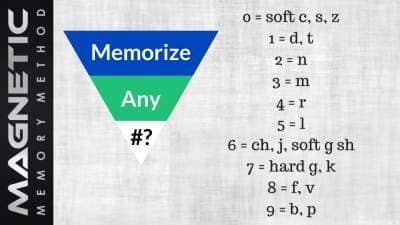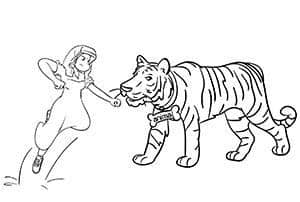Podcast: Download
Subscribe: Apple Podcasts | RSS

No, this uniquely popular mnemonic system was given this name because history has tended to attribute the technique to a person named Major Beniowski.
And you know what? I personally find it majorly exciting to use!
That’s because, regardless of its name, the Major System helped me in some tremendous ways. I used it to get my PhD at York University, learn several languages and even hold my own in a memory competition against a two-time Guinness World Record holder for numbers.
On this page, I’ll share exactly how to use this mnemonic system yourself for memorizing any number.
And I’ll share a number of use cases and how the Major System can be used to learn formulas that involve symbols and other information.
Ready to get started?
Let’s dive in!
What Is The Major System?
The mnemonic major system is a very old mnemonic technique, older and much more powerful and faster than number rhymes. People have used it for centuries to help remember numbers, everything from credit card numbers and phone numbers to thousands of digits of pi.
You might think I’m joking, but Akira Haraguchi has done just that – using the Japanese version of this powerful system.
Using Tony Buzan‘s SEM3 technique, many early memory competitors also used it to win year after year. The Major is still at the core of newer techniques like the Shadow, which competitors like Alex Mullen and Braden Adams have used to stunning effect.
Here’s how the English version of the Major System works:
You start by converting the digits 0-9 into consonant sounds. This is basically a form of chunking, and the most common pairs people use are listed below. I’ve included some ideas for how you can rapidly remember the system with each pair:
- 0 → S or Z (sounds like the “s” in “zero”)
- 1 → T or D (sounds like the “t” or “d” in “toad”)
- 2 → N (has two downstrokes, resembles the letter “n”)
- 3 → M (has three downstrokes, resembles the letter “m” or a moustache on its side)
- 4 → R (the word “four” has four letters and ends in “r”)
- 5 → L (hold your whole hand with the thumb out and the hand makes the “L” shape)
- 6 → J, Sh, Ch, or Soft G (a cursive “j” has a similar shape to “6”)
- 7 → K, G (hard), C (hard), or Q (a “k” can be seen as two mirrored 7s)
- 8 → F or V (cursive “f” and “8” look similar)
- 9 → P or B (both have a loop resembling “9”)
Note that most people leave all vowels out of the system (A, E, I, O, U) . However, vowels are used to form meaningful words or phrases from the consonants. I’ll show some examples below.
Simon Luisi, a Canadian mnemonist and organizer of the Canadian Memory Championship event, has shared a variation where 3 is also paired with W and 7 with Y.
This approach is especially useful for native French speakers, and he joined me on the Magnetic Memory Method Podcast to discuss this approach here:
In addition to Simon’s variations, you’ll find different versions in many languages. Languages like Spanish and Russian each arrange the Major System’s consonants to help native speakers of these languages create the maximum number of words.
Assigning Mnemonic Images Using The Major System
Getting the arrangement to maximize the possible amount of words is important because that’s the next step involved in mastering this mnemonic technique: turning numbers into words. Here’s a simple example:
To remember the number 123, you could break it down like this:
- 1 → T or D
- 2 → N
- 3 → M
From this arrangement, you might form the word “Denim” (D-N-M).
Or if you had to memorize 22, you could imagine a nun. If you had a number like 22235, you could imagine a nun attacking an “animal” like a tiger:
For a more advanced version that works much faster for many people, check out this detailed tutorial on a related mnemonic strategy known as the PAO System. (That’s the system I wish I had been using when I competed against Dave Farrow… but I actually still did pretty good with just the Major. Full story of that competition here.)
A Detailed History of the Major System
For a quick and fun overview of this system’s history, check out this YouTube video:
Mnemonic systems for numbers are just one of many ancient memory techniques. Many people attribute the Major System to the Greek and Romans who used number systems in combination with the Method of Loci.
The Major System is much older, however. The earliest version I’ve found is called the katapayadi. You can also find the ancient Hebrew version in Eran Katz’s Where Did Noah Park the Ark?
In the West, these systems really start to take shape in the 16th and 17th centuries through people like Giordano Bruno and Robert Fludd. They both used letters and consonants to represent numbers, but their systems were often inconsistent and lacked a standardized approach. The following people brought more of the standardized system into use that I described for you above.
Johann Justus Winckelmann
Johann Justus Winckelmann was a German mathematician and mnemonist. He proposed a method where each digit was always associated with the same specific consonants, laying the groundwork for later developments.
Aimé Paris
As a French mathematician and memory expert, Aimé Paris simplified the associations, making the system more user-friendly. His version is nearly identical to the Major System as we know it today.
Major Beniowski and the Naming of the System
The Major System is named after Major Beniowski, the 19th-century linguist, memory expert and author of the strangely titled, The Anti-Absurd or Phrenotypic English Pronouncing and Orthographical Dictionary.
Not much is known about him. Some people believe that “Major” refers to Beniowski’s military rank. True or not, the name clearly underscores his “major” role in popularizing and standardizing this mnemonic method. Through his teachings and writings, Beniowski helped spread the use of the system, making it accessible to a wider audience.
Further Refinement and Popularization
The Major System continues to evolve and gain popularity. Memory experts like Harry Lorayne brought it to the masses. Later books like Moonwalking with Einstein encouraged many people to incorporate the system into their learning lives.
As I mentioned, the technique continues to evolve, with a lot of competitors now using a variation called the Shadow.
Even the Shadow is undergoing transformations, but as far as I can tell, they are all based on the same core alpha-numeric code you discovered in this tutorial a few sections above this one.
If you want to check out some of the most impressive users of the Major, check out my podcast episodes with Katie Kermode and Don Michael Vickers. These memory athletes are seriously impressive.
How to Use the Major System in a Memory Palace
There’s a lot to say about creating and using Memory Palaces. In brief, this memory technique involves setting up a mental construc based on a real location.
Like your house.
Or your school.
Or your church, your favorite movie theater or restaurant.
The important thing is to create a mental journey through the Memory Palace that is clear and crisp so that you don’t have to think about it.
Once you’re set up, convert the numbers you need to memorize into consonants. Then form words or phrases by adding vowels or other non-consonant sounds. These words should be vivid and memorable and follow the principles you can learn by using these visualization exercises.
Next, place the words you come up with in a Memory Palace. Basically, you’re associating each word as a mnemonic image with the location. Do this as vividly as possible, with lots of detailed and interactivity.
Here are some examples:
Example 1: 314
3 → M
1 → T or D
4 → R
Word: “Meter”
Memory Palace Placement: Imagine a large meter on the wall of your bedroom.
Example 2: 72
7 → K or G
2 → N
Word: “Gun”
Memory Palace Placement: Picture a gunman standing in the kitchen, guarding the fridge.
By placing these images in specific locations within your Memory Palace, you can mentally walk through the space and easily recall the numbers associated with each image.
How to Get Numbers Into Long Term Memory
This next step is very important.
Although you will increase your ability to memorize this information greatly by not only creating a crazy image and sticking it in a Memory Palace, you can and should lock it down for the long haul.
You do this by revisiting the imagery several times. I suggest you specifically use a process called spaced repetition.
It’s really easy. You’ve created a Memory Palace and you know exactly where to look for that tiger-attacking nun 22235.
And if you’ve got ten pieces of information along that journey, it’s easy to travel it and decode each image. It’s almost like watching a movie.
I recommend that you revisit that journey and watch that movie you’ve created (making sure to decode the imagery and practice retrieving the information) at least 5 times the first day. This suggestion is based on remarks by Dominic O’Brien who created an alternative number mnemonic system called The Dominic System.
What To Do If You Have An Exam Coming Up
If you’re studying for an exam that involves historical dates or formulas, I’d recall the numbers five times a day for a week and then at least 1-2 times a week thereafter. Do this for as long as you want to keep the imagery fresh and available.
It will probably still be there if you don’t perform this Magnetic Memory Method Recall Rehearsal, but you might have to fish around for it.
But if you’re serious about being able to recall the information, you’ll revisit it more than a few times to get it down cold. That’s just how the method of loci works best. Every good Memory Palace book stresses the same point.
And the best part is that you’ve done so without having to use index cards or any weird and boring stuff like that. The only time that it’s good to repeat information over and over again is when you’re using your imagination to do it. That makes both your memory and your imaginative abilities stronger and stronger.
Intermediate & Advanced Major System Techniques For Memorizing Numbers
Once you have the basics of the Major Method down, you might want to learn how to create a Person Action Object (PAO) or 00-99 system. For that, please check out The 3 Most Powerful Techniques For Memorizing Numbers.
These next-level techniques for memorizing numbers will then help you in other areas, such as human anatomy. Learning numbers related to blood flow through the heart, for example, are easier and faster to absorb when using the Major System.
You can also think about using a Major System to help you memorize any book. All you need to do is call upon words or images for each page based on the page number.
For example, if you want to memorize a fact on page 75 of a book, you use an image built from the Major System to remember the location in the book. Then you use the page as the Memory Palace.
I did exactly this when I wanted to recall a point about episodic memory in Maps of Meaning. I turned 75 into John Cale and had him interacting with Freud and Shakespeare, who are related to memory science related to how we remember ancient wisdom.
You can also easily use the Major System in combination with a Memory Palace for language learning. I normally use alphabetical associations, but when I can’t think of images for some words, I just think through the consonants as numbers in the Major System and then start using that image. Even if it’s not perfect or doesn’t exactly reflect pronunciation, it’s at least a starting point.
As a recent example, I did this with a Sanskrit phrase. Although I later realized that a celebrity I’m aware of was better than my image for 07 (Oliver Sacks), at least working with Sacks to get started with “suktikarajatam” led me to think about using Sook-Yin Lee.
In my research, this kind numerical bi-directionality for using number systems to help memorize words is seen in memory training books as early as Aristotle’s Nuclear Alphabet and The Imaginary Memory Palace Method of Hugh of St. Victor.
How To Practice The Major System
There are a few cool ways to practice the Major System once you’ve learned it.
- Take memory number tests frequently.
- Keep a journal as suggested by accomplished memory athlete Johannes Mallow.
- Put numbers on flash cards and test yourself manually.
- Use the International Association of Memory’s free software for generating random numbers.
- Attach the Major System to a pack of playing cards and memorize their order.
How often should you practice?
It’s really up to you, but as I discuss in my book on how to memorize numbers, math and equations, I usually practice 3-4 times a week, typically by using the final method: playing cards. But all of the above methods are a lot of fun!
Using The Major System For Memorizing Formulas
Yes, you can do that too in every area, ranging from chemistry to physics, biology to computer science and programming. You can also apply the Major to speed math and becoming a mental calculator.
The trick is always to make sure that you have all of the systems I describe in the video above ready to go so that you can rapidly encode either the numbers or the symbols that you see.
To make sure you have an image for each letter of the alphabet, make sure to read this tutorial on the pegword method.
For symbols, you need to come up with images that remind you of the name of the symbol and what it looks like. To give you a quick example: When I was learning the formulas used in logic, I imagined a totem pole for totality and an air conditioner blowing cold air on one of the Ninja Turtle’s weapons for condition.
For even more advanced techniques related to numbers and equations with examples, please go through my detailed tutorial on how to memorize a textbook next.
And make sure to sign up for my free memory course here:
It gives you free worksheets and videos that walk you through getting your Memory Palaces and images created optimally in minimum time. But with maximum effect.
So what do you say?
Are you ready to get out there and master the Major System?
Make it happen!
Related Posts
- Tap The Mind Of A 10-Year Old Memory Palace Master
Alicia Crosby talks to us about how she memorized all of Shakespeare's plays in historical…
- Memory Improvement Techniques For Kids
You're never too young to get started with memory techniques
- The Memory Code: Prehistoric Memory Techniques You Can Use Now
Lynne Kelly, author of The Memory Code, shares her personal experiences learning ancient memory techniques…









2 Responses
One doubt, when we create associations and place them in the memory palace, do we always need to retrieve our crazy multisensory images, or does the target information come to mind when we pass through the stations?
Thanks for this question.
The answer really depends on the extent to which you have appropriately used Recall Rehearsal to establish long-term retention.
My personal goal for memorizing historical dates and other numerical matter when using the Major System is to develop knowledge that comes to mind without having to revisit the Memory Palaces. That’s why I use Recall Rehearsal so deliberately. And I strongly suggest others do the same if they also want to enjoy long-term recall of any information, not just numerical data.